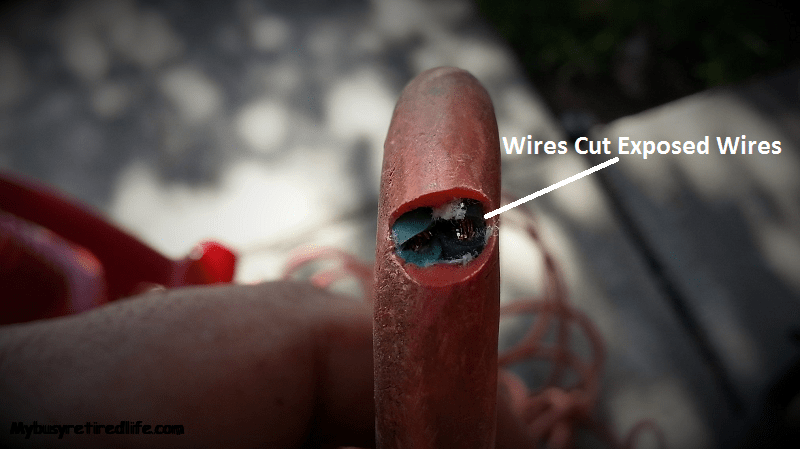Repair a cut extension cord
I needed to repair a cut extension cord. My wife used my hedge trimmers again. As usual, there was a deep cut about a foot from the end of the cord. This is a simple repair easily adapted to different circumstances. If you have a cord that needs a new end(either one), this is the article for you.
Start with a cut cord. My case is pretty standard around my house. I was going to lose about a foot of the cord length. I already had a replacement end on the cord. So this job was only moving the end.
If your cut is in the middle of the cord you have to make a decision. You will need to decide whether to make the cord into two pieces or keep it in one piece. To make it two cords you will need to replace the cut with male and female ends in order to save your cord. You will have two shorter cords but the overall length will still be about the same.
Procedure to replace the cord end
- Safety first, unplug the cord if plugged into power.
- Cut thru the cord where the cord was cut.
- Be careful not to cut thru the wire’s jacket. Cut the outer cable jacket away. Expose about 2 1/2″.
- Leave 3/4″ of insulation. Cut thru the insulation but not the stranded wire.
- Pull the cut insulation away about a 1/8″. Start twisting the wire clockwise.
- Keep twisting while pulling the insulation off the wire. Pull until the insulation comes away from the stranded wire.
- Repeat for each wire.
Why so Long?
Before I continue let me explain why the length of the exposed wires is so long. Most methods have you expose 3/4″ of the wire. Then you push the wire into the left side of the terminal screw and tighten. I don’t like this method. It leaves the all the stress on such a short length of wire. This in spite of the plug end having a strain relief clamp. I like the wire to wrap around the terminal. This wrap provides resistance. So if pulled it helps hold the wire on the terminal screw. Also, I like the bare stranded wire to wrap around the terminal screw a full 180º. It holds onto the wire much better and with less chance of a wire pulled off the terminal screw. This method provides three layers of protection keeping your wire tight on the terminal.
Putting everything together
- Start with the black wire.
- If the plug end will allow, pull the insulated part of the wire thru the plug end so that it slightly wraps the terminal.
- Put the exposed part of the wire against the terminal screw. Wrap it around the screw. Have it form a horseshoe shape.
- Cut off any part that will not be under the screw.
- Tighten the terminal screw. Make sure all strands of bare wire are under the screw.
- Recap: the exposed part of the wire starts at the left side of the terminal screw. It wraps around the screw for 180 degrees and ends under the screw. All strands of exposed wire are under the tight screw.

Cord-Strain-Relief
- Repeat for each wire.
- Push the cord into the plug end. The wires must not be stretched tight in the cord end.
- Tighten the strain relief.
Procedure To Reconnect The Wires By Soldering
If you want to keep your cord in one piece the following technique is highly recommended. You will need a soldering iron. This will result in a one-piece cord of the original length. The splices are soldered. The electrical resistance at the cut is lower due to soldering. Each soldered joint is protected and insulated by shrink-wrap tubing. Then the three splices are covered by another shrink wrap. This ties all three splices together. It also provides water resistance.
Conclusion
If you have a cut extension cord you will need to do something about it. Wrapping it in electrical tape will not protect you from shocks or something worse if you can see the stranded wire. Do it right. One of the above procedures will have your cord back in tip-top shape.
Related Article: Electrical Cord Storage Without Tangles
(Mybusyretiredlife.com All Rights Reserved)
(Mybusyretiredlife.com All Rights Reserved)
(Mybusyretiredlife.com All Rights Reserved)
(Mybusyretiredlife.com All Rights Reserved)
(Mybusyretiredlife.com All Rights Reserved)
(Mybusyretiredlife.com All Rights Reserved)
(Mybusyretiredlife.com All Rights Reserved)
(Mybusyretiredlife.com All Rights Reserved)








